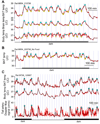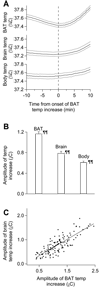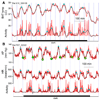Brown adipose tissue thermogenesis heats brain and body as part of the brain-coordinated ultradian basic rest-activity cycle
- PMID: 19679172
- PMCID: PMC2767384
- DOI: 10.1016/j.neuroscience.2009.08.013
Brown adipose tissue thermogenesis heats brain and body as part of the brain-coordinated ultradian basic rest-activity cycle
Abstract
Brown adipose tissue (BAT), body and brain temperatures, as well as behavioral activity, arterial pressure and heart rate, increase episodically during the waking (dark) phase of the circadian cycle in rats. Phase-linking of combinations of these ultradian (<24 h) events has previously been noted, but no synthesis of their overall interrelationships has emerged. We hypothesized that they are coordinated by brain central command, and that BAT thermogenesis, itself controlled by the brain, contributes to increases in brain and body temperature. We used chronically implanted instruments to measure combinations of bat, brain and body temperatures, behavioral activity, tail artery blood flow, and arterial pressure and heart rate, in conscious freely moving Sprague-Dawley rats during the 12-h dark active period. Ambient temperature was kept constant for any particular 24-h day, varying between 22 and 27 degrees C on different days. Increases in BAT temperature (> or = 0.5 degrees C) occurred in an irregular episodic manner every 94+/-43 min (mean+/-SD). Varying the temperature over a wider range (18-30 degrees C) on different days did not change the periodicity, and neither body nor brain temperature fell before BAT temperature episodic increases. These increases are thus unlikely to reflect thermoregulatory homeostasis. Episodic BAT thermogenesis still occurred in food-deprived rats. Behavioral activity, arterial pressure (18+/-5 mmHg every 98+/-49 min) and heart rate (86+/-31 beats/min) increased approximately 3 min before each increase in BAT temperature. Increases in BAT temperature (1.1+/-0.4 degrees C) were larger than corresponding increases in brain (0.8+/-0.4 degrees C) and body (0.6+/-0.3 degrees C) temperature and the BAT episodes commenced 2-3 min before body and brain episodes, suggesting that BAT thermogenesis warms body and brain. Hippocampal 5-8 Hz theta rhythm, indicating active engagement with the environment, increased before the behavioral and autonomic events, suggesting coordination by brain central command as part of the 1-2 h ultradian basic rest-activity cycle (BRAC) proposed by Kleitman.
Figures







References
-
- Alfödi P, Rubicsek G, Cserni G, Obal F., Jr Brain and core temperatures and peripheral vasomotion during sleep and wakefulness at various ambient temperatures in the rat. Pflugers Arch. 1990;417:336–341. - PubMed
-
- Aschoff J, Pohl H. Rhythmic variations in energy metabolism. Fed Proc. 1970;29:1541–1552. - PubMed
-
- Bailey D, Harry D, Johnson RE, Kupprat I. Oscillations in oxygen consumption of man at rest. J Appl Physiol. 1973;34:467–470. - PubMed
-
- Baker F, Angara C, Szymusiak R, McGinty D. Persistence of sleep-temperature coupling after suprachiasmatic nuclei lesions in rats. Am J Physiol. 2005;289:R827–R838. - PubMed
-
- Baker M, Hayward J. Autonomic basis for the rise in brain temperature during paradoxical sleep. Science (New York, NY) 1967;157:1586–1588. - PubMed
Publication types
MeSH terms
Grants and funding
LinkOut - more resources
Full Text Sources

